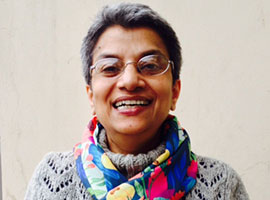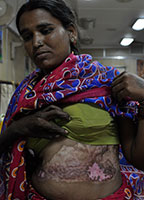Original article by Mamta Bhushan Singh, MD, and Michael F. Finkel, MD. published 10 May 2016 in World Neurology Vol 31 No. 3
 |
Mamta Bhushan Singh, MD |
The medical world thinks of the developed and developing societies in terms of diagnostic and treatment differences. However, there are realities that are common to both spheres concerning most medical conditions.
As a medical student, one would read of common disorders that were not being treated. Epilepsy was a striking example. In many rural Indian communities, up to 90 epilepsy patients out of every 100 were not getting treatment. In bureaucratese, this was a treatment gap of 90 percent.
 |
Michael F. Finkel, MD |
The treatment of epilepsy has since evolved. Over two-dozen antiepileptic drugs are currently available. Many drugs are off patent and generically manufactured, and available in India and other developing nations at reasonable prices. But the epilepsy treatment gap of up to 90 percent still exists in many rural Indian communities! So, why has nothing changed for the lot of millions of epilepsy patients?
Let us humanize the numbers. By using calculations from an often-quoted epilepsy prevalence figure of 1 percent of the population, at least 12 million Indians are struggling with epilepsy.1 Large prevalence studies are unavailable, and many experts agree that this number is more likely to be closer to 15 million or even higher. This implies that more than 10 million epilepsy patients in India are untreated. Extrapolating worldwide, there are more than 50 million epilepsy patients and at least 40 million of these reside in developing countries. The estimate is that 75 percent of patients in developing countries are outside the domain of any kind of effective treatment. This implies at least 30 million untreated persons.
Ironically, epilepsy is one of the relatively easily controllable neurological diseases.
 |
Untreated epilepsy with frequent generalized tonic-clonic seizures results in serious injuries and burns. Patients may lose sight, digits, or limb. The visible scars are further stigmatizing for patients who struggle with societal acceptance. Photo credit: Priya Jain. |
What is life like with untreated epilepsy? Most persons with epilepsy who do not have any other neurological illness are essentially normal at all times other than during their seizures. A seizure generally lasts for a few minutes during which, amongst other things, the person is unaware of his or her surroundings, and after which the person may remain confused for a variable amount of time or may sleep off the effects. In either case, the individual is back to normal within a few hours, often without even requiring a trip to the doctor's clinic or the emergency room.
Then what is the great problem about having untreated active epilepsy with an occasional seizure? Imagine having brief episodes of unawareness just once or twice in a month, in six months or even in a year, but not knowing when these would happen. So, you may be driving to work, crossing the street, climbing a tree, in bed with your partner, swimming in the pool, or speaking mid-sentence in that all important meeting. Suddenly, out of the blue, you start convulsing or just fidgeting with your buttons or speaking in an unintelligible jargon or wet your clothes in full public gaze. How would it feel to know that you had done either of these, and then have to go back to the same people in front of whom this had happened? Well, that is assuming that these people agree to work or socialize with you after witnessing a seizure.
The economic impact of untreated epilepsy is formidable in all societies. Many untreated epilepsy patients remain unemployable, especially if local attitudes consider it to be a contagious disease, a mental illness, or a demonic possession. Thus, they are removed as contributors to the economy. Even if they are poor and have minimum wage jobs, this still adds up to a substantial amount of money loss because of the millions affected.
There are other grave consequences of untreated epilepsy. If the patient is of school or college age, they are very likely to have to drop out. This is either due to their parents' fear that their child may be injured during a seizure, or on the insistence of teachers. With limited scope for education, landing a good job later in life is subsequently reduced. The intrigue and misinformation surrounding epilepsy reduces social acceptance of patients. Any relationship, including a stable marriage, especially for women with epilepsy, is unlikely. Abandonment of women with epilepsy and their children from marital relationships is common. Such women, with little or no education, no skills and sometimes also with small children to take care of, are often left at the mercy of an impoverished community.
So, is epilepsy difficult to treat? No. Epilepsy is a relatively easy disease to treat in most patients. The diagnosis is clinical and based upon eliciting a history of stereotyped episodes during which the patient may behave abnormally, have involuntary movements or jerks, generally become unaware of his surroundings and then recover in a short time. After the clinical diagnosis, a couple of investigations— EEG and brain imaging — may be done. Investigations may help in deciding the best anti-epileptic drug, in prognosticating how long the treatment is likely to be needed, and how responsive to treatment the patient's epilepsy might be. ■
(At time of publication, May 2016) Mamta Bhushan Singh, MD, DM is an additional professor, department of neurology, All India Institute of Medical Sciences, New Delhi, India.
Michael Finkel is a retired neurologist, and a member of the AAN, Child Neurology Society, ENS, EFNS, and BMA. He is a fellow of the AAN..








